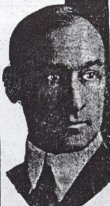The Evansville Press, May 6, 1928
Article was typed as it was worded in the newspaper.
City Should Boom Pioneer History, Says Local Sculptor
Honig Gives New Slant on Artists' Life in Interview
This is the third of a series of interviews with Evansville people whose names appear in that roster of celebrated Americans, "Who's Who."
 Honig, George Honig, sculptor; b. Rockport, Ind., 1881; s. Simon and Mary (Honig) H.; ed. high school and Ind. U.; studied art, Nat. Acad. Design, New York; m. Alda McCoy Honig of Richland, Ind., June 12, 1917. Awarded Suydam bronze medal, 1914, Suydam silver medal 1915, Nat. Acad. Design. Many works among them display fountain, Shelbyville, Ind.; Soldiers' Group, Joilet, Ill.; bronze portrait of Audubon, Henderson, Ky.; group "The Spirit of Sixty-one," etc., Evansville, Ind. Mem. Sigma Chi. Home, 208 ½ Locust st. Studio: 314 Mercantile Bank Bldg., Evansville, Ind. (Ed. note: Honig was born 8-3-1874.)
Honig, George Honig, sculptor; b. Rockport, Ind., 1881; s. Simon and Mary (Honig) H.; ed. high school and Ind. U.; studied art, Nat. Acad. Design, New York; m. Alda McCoy Honig of Richland, Ind., June 12, 1917. Awarded Suydam bronze medal, 1914, Suydam silver medal 1915, Nat. Acad. Design. Many works among them display fountain, Shelbyville, Ind.; Soldiers' Group, Joilet, Ill.; bronze portrait of Audubon, Henderson, Ky.; group "The Spirit of Sixty-one," etc., Evansville, Ind. Mem. Sigma Chi. Home, 208 ½ Locust st. Studio: 314 Mercantile Bank Bldg., Evansville, Ind. (Ed. note: Honig was born 8-3-1874.)
This brief biography in "Who's Who in America" gives only a sketchy conception of the life of the Evansville sculptor, George Honig.
If you can read between the lines, you'll be able to see a young man with the shining light of ambition in his eyes, high in a New York building, molding plastic clay again and again in a studio-you'll see him in innumerable art classes, sketching, studying, shaping clay with his hands, day after day, year after year, only to do it over again.
For that is the price of being an artist.
But Sculptor Honig, sitting in his little studio in the Mercantile Bank building, likes to forget those years of agony and relentless toil, and recall only the time when he got his first big commission, and came here in 1916, to make the well known Coliseum group.
Of course, he ascribes his good fortune in getting that commission to those student years, when he studied in New York under such eminent artists as Herman A. MacNeil, Thomas Fogarty, Frances C. Jones and Charles Niehaus.
Honig is middle-sized man with a somewhat long, kindly face, wearing glasses usually perched somewhere near the end of his nose, so that he looks at you over the tops of them. His warm, brown eyes were no alight with fervor.
"People ordinarily think of a sculptor," he said, "as a man armed with a chisel, who attacks a block of stone with a hammer and inspiration. Such is far from being the case. The man who actually chisels the stone is called a carver."
What the artist does is about as follows: First, he sketches his proposed work on a piece of paper, then does what is known as a "sketch size" in clay; then he calls in models and makes a "study sizeV also in clay; one-third to one-half the actual size of the finished product; the full-size model is then done in clay, and is cast in plaster model; this goes to the carver, who chisels and hews it from the stone, according to mathematical measurements.
"If the sculptor is making his work in stone, he must think of it as in stone from the start. If he is doing it in bronze, he must think in bronze while modeling and designing from the clay. A bronze, of course, is cast from the plaster figure. After the carver of the caster finishes, the artist is supposed to come and put on the finishing touches."
In Honig's opinion, this city needs to develop her pioneer history and he sees the possibility of doing this thru art.
"Why, Evansville," he declared, "has an historic background such as no other city in the state of Indiana can claim. History was being made hereabouts while most of the other parts were still covered with wilderness."
He has a vision of great memorial approaches to the proposed new bridge over the Ohio river at Evansville. These, as he sees them, would have to be of heroic size, something like the buffaloes on the bridge at Washington, D. C. One of the approaches would be for the heroes of the World war, particularly James Bethel Gresham, and the other for the pioneer heroes such as George Rogers Clark, Abraham Lincoln, Robert Owen, Audubon, Daniel and Ratliff Boone, and Col. Richard Henderson.
"I don't believe modernistic sculpture will endure," said Honig, "although parts of it are good-it shows flashes of true genius, like jazz. But I think this phase of art will lead into another school which will turn out true art. This happened in France during the impressionistic period, and the critics and people all howled against it. But it produced a new school which in turn produced real art."
Honig believes that decorative sculpture will hold the great place in the future.
"The eye," he pointed out, "must be pleased in sculpture. After art has pleased and satisfied the eye, it must please and satisfy the soul. Great art will please the majority of the people and the critics too. That's why decorative sculpture will come finally into its own."
Besides the sculptures mentioned in "Who's Who," Honig has fashioned "The Hiker" standing in Fairmont park, at Denver, Colo. and has done 13 bronze World war memorial tablets in cities over the country.